There are several variations of cranes found in metal buildings today. Many of them are very affordable but they can be limited in both range and capacity. This blog will explore some of the most commonly used varieties and try to explain their general limitations.
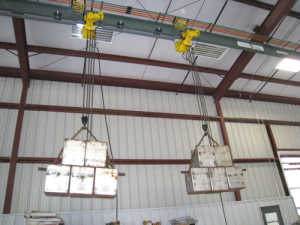 Monorail Cranes are generally used for lighter weight applications. More commonly found in small work shops. The monorail crane only travels back and forth down a single beam. This crane beam is mounted to run either parallel or perpendicular to the main frames on a metal building. Hoist & trolleys are often manually operated. However an electric hoist can be added relatively easily.
Monorail Cranes are generally used for lighter weight applications. More commonly found in small work shops. The monorail crane only travels back and forth down a single beam. This crane beam is mounted to run either parallel or perpendicular to the main frames on a metal building. Hoist & trolleys are often manually operated. However an electric hoist can be added relatively easily.
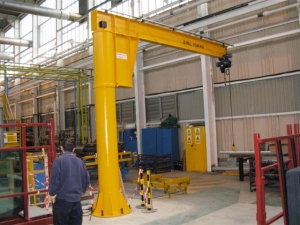 Jib Cranes are very different from monorail cranes. Although they use a similar monorail & hoist design the rail itself is mounted differently. The jib cranes monorail swivels at a pivot point mounted to either the metal building column or sometimes through the buildings foundation. The jib crane does not have the same reach as the monorail but it has increased mobility due to its pivoting action. These cranes are often used at workstations in conjunction with larger capacity bridge cranes.
Jib Cranes are very different from monorail cranes. Although they use a similar monorail & hoist design the rail itself is mounted differently. The jib cranes monorail swivels at a pivot point mounted to either the metal building column or sometimes through the buildings foundation. The jib crane does not have the same reach as the monorail but it has increased mobility due to its pivoting action. These cranes are often used at workstations in conjunction with larger capacity bridge cranes.
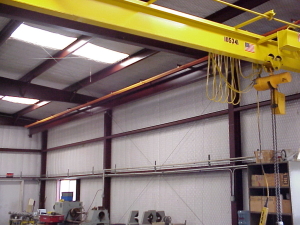 Bridge Cranes are most commonly used in industrial environment. There can be fully motorized and travel back and fourth and side to side. They generally have greater lifting capacities and the greatest reach. The biggest down side is the expense. This type of crane is substantially more expensive. Not to mention the metal building requires additional reinforcing to support the bridge crane.
Bridge Cranes are most commonly used in industrial environment. There can be fully motorized and travel back and fourth and side to side. They generally have greater lifting capacities and the greatest reach. The biggest down side is the expense. This type of crane is substantially more expensive. Not to mention the metal building requires additional reinforcing to support the bridge crane.
Existing Buildings:
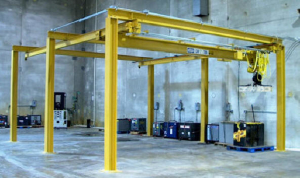 Typically metal buildings are not designed for use with a bridge crane but what happens when one is needed in an existing building that was not designed for it. In some cases the building may have enough support for a simple monorail crane. Our 40’ wide wedge beam frame for example will support up to a ¾ ton monorail crane with no additional bracing. A bridge crane is another story all together though. In this case we recommend a freestanding crane that is self supporting. The downside is the fact that the supporting structure takes up more room than a crane that is mounted to the building. This tends to limit the cranes travel in all directions. As in most cases planning ahead is cheaper & more effective than retro fitting later on.
Typically metal buildings are not designed for use with a bridge crane but what happens when one is needed in an existing building that was not designed for it. In some cases the building may have enough support for a simple monorail crane. Our 40’ wide wedge beam frame for example will support up to a ¾ ton monorail crane with no additional bracing. A bridge crane is another story all together though. In this case we recommend a freestanding crane that is self supporting. The downside is the fact that the supporting structure takes up more room than a crane that is mounted to the building. This tends to limit the cranes travel in all directions. As in most cases planning ahead is cheaper & more effective than retro fitting later on.
Summary:
Over head cranes can be expensive and sometimes tough to justify but try to imagine this scenario. You need help unloading something from your truck. With no one in sight you think to yourself “I can handle this one”. The next series of events ends up with an injury. This scenario could be further complicated if it happened to an employee. Imagine the loss of time on the job, potential lawsuits, worker comp claims & the cost of forgone opportunities. Think about it like this; an overhead crane is much more convenient & is cheaper than most work related injuries.

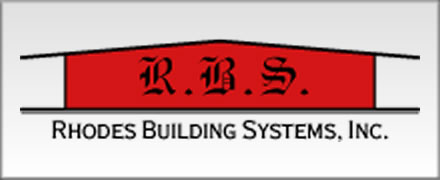
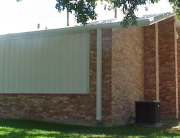
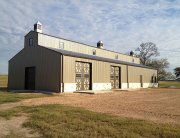
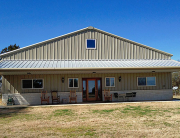
Leave A Comment